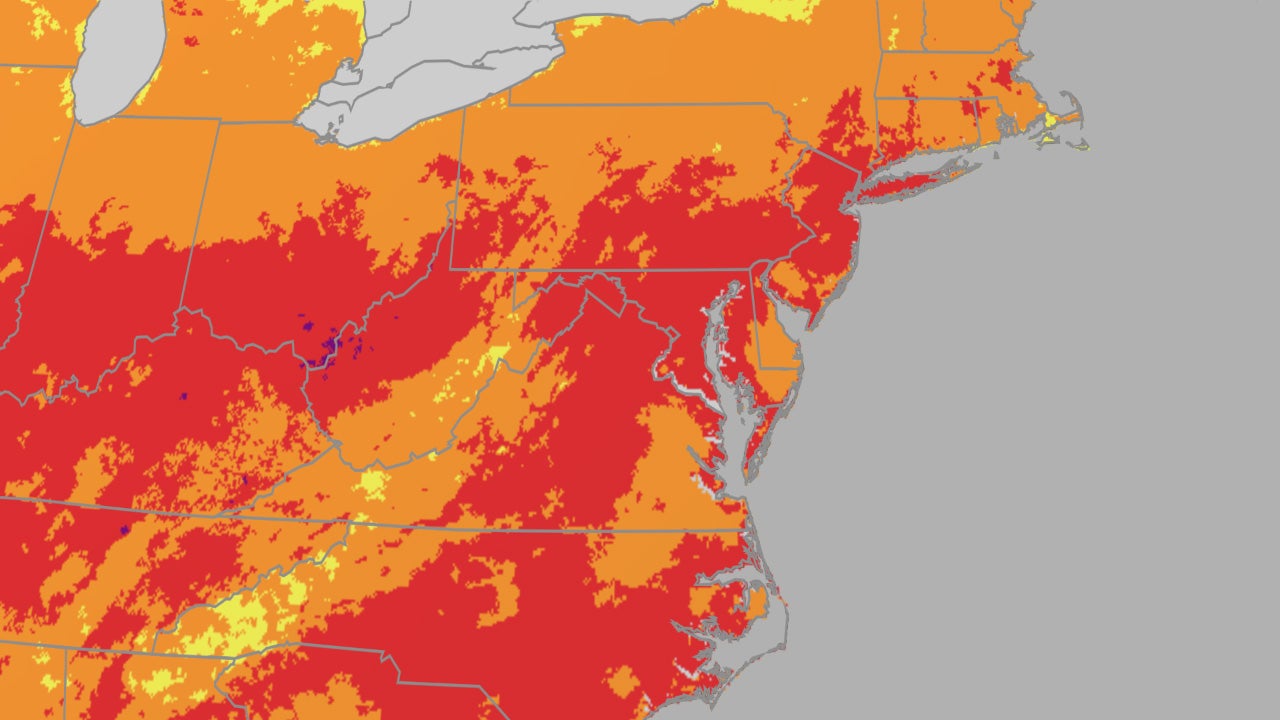
The Silent Threat: Why Nighttime Heat Matters
The Northeast is bracing for a scorching heatwave, with temperatures flirting with record highs. While the daytime heat is a visible danger, many overlook the equally insidious threat of nighttime heat. This article delves into the hidden dangers of warm nights and offers crucial advice on staying safe when the sun goes down. Understanding the risks associated with high nighttime temperatures is essential for safeguarding your well-being during the summer months. The information will cover the potential health impacts, the areas most at risk, and practical steps you can take to protect yourself and your loved ones.
The intensity of the heat can be measured in various ways, including the heat index. This accounts for the combined effect of temperature and humidity, providing a more accurate assessment of how hot it feels. The combination of heat and humidity can be particularly dangerous, especially for those without access to air conditioning. This is because our bodies have a harder time cooling themselves down when the air is already saturated with moisture. The Northeast corridor, including major cities, is particularly vulnerable. High population densities and urban environments can exacerbate the effects of heat, creating what is known as the “urban heat island” effect, which leads to warmer nighttime temperatures.
Moreover, the impact of nighttime heat extends beyond immediate discomfort. Sleep quality can deteriorate, leading to fatigue, reduced cognitive function, and a weakened immune system. These effects are compounded by the fact that the body is unable to recover from the heat of the day if the nights remain oppressively warm. It is crucial to prioritize staying cool at night and implement strategies that minimize the risks associated with nighttime heat. It’s not just about the daytime highs; how we fare when the sun sets plays a significant role in our overall health and well-being.
Unveiling the Danger: The Impact of Warm Nights
So, what exactly makes warm nights so dangerous? Why is it more than just a matter of discomfort? The primary threat is the body’s inability to recover from the day’s heat. Normally, when the sun goes down, our bodies cool off through sweating and radiating heat. But when nighttime temperatures remain high, the body struggles to regulate its internal temperature. This leads to a range of health problems, especially for vulnerable groups. The impact of prolonged exposure to warm temperatures is multifaceted, affecting various aspects of health and well-being. The risks can be particularly acute for certain populations, including the elderly, children, and individuals with chronic illnesses.
Consider the impact on sleep. When temperatures remain high, it becomes difficult to fall asleep and stay asleep. This sleep deprivation can lead to fatigue, irritability, and impaired cognitive function. Furthermore, it can weaken the immune system, making you more susceptible to illness. Moreover, warm nights can exacerbate existing health conditions. For example, individuals with cardiovascular issues are at increased risk of heart attacks and strokes during heatwaves. Respiratory problems can also worsen as air quality deteriorates due to heat and humidity. Therefore, the impact of warm nights is much more than a minor inconvenience. It is a serious threat to health and well-being, demanding proactive measures to mitigate the risks.
Understanding these dangers is the first step toward protection. By recognizing the potential health consequences and taking preventative actions, you can safeguard yourself and your loved ones during hot summer nights. It involves practical strategies and a proactive approach to staying cool and minimizing the risks associated with elevated nighttime temperatures. The importance of recognizing the impact of warm nights on our health cannot be overstated, urging us to take necessary steps to protect ourselves during the summer months.
Who’s Most at Risk During a Nighttime Heatwave?
While everyone is affected by high temperatures, certain groups are at a higher risk of experiencing negative health consequences during a heatwave. These populations have specific vulnerabilities that increase their susceptibility to heat-related illnesses. Knowing who is most at risk will help you identify and support those who need it most. A variety of factors can contribute to heightened risk, including age, health conditions, and socioeconomic factors. Focusing on the well-being of at-risk individuals and ensuring they have access to resources and support can significantly reduce the negative impacts of a heatwave. Let’s examine these at-risk groups in detail.
The Elderly: Older adults often have diminished thermoregulatory systems, making it harder for their bodies to cool down. They may also have chronic health conditions and take medications that can interfere with the body’s ability to regulate temperature. Additionally, many older adults live alone and may not have access to air conditioning or support networks. The elderly are uniquely vulnerable to the effects of heat and need extra care and attention. Ensuring they have access to cooling facilities, staying hydrated, and monitoring their health are all critical.
Children: Young children are also at increased risk because they are less able to regulate their body temperature effectively. They may not be able to recognize the signs of heat stress and are more reliant on caregivers to provide hydration and a cool environment. Furthermore, children spend a significant amount of time outdoors, participating in activities that expose them to the sun and heat. Parents and caregivers must keep children cool, provide adequate hydration, and watch for signs of heat-related illness. The safety of children during heatwaves depends heavily on vigilance and proactive measures.
How to Stay Safe During Nighttime Heat
Now that we’ve examined the dangers and those at risk, let’s focus on proactive strategies for staying safe during nighttime heat. Here are some key steps you can take to protect yourself and your loved ones. These measures are intended to reduce the risk of heat-related illnesses and to help everyone stay comfortable and healthy. The practical measures will help you create a cooler environment, stay hydrated, and monitor for any signs of heat-related illness. Implementing these tips will make a significant difference in your well-being during a heatwave.
Cooling Your Home: The most effective way to beat nighttime heat is to create a cool environment in your home. If you have air conditioning, ensure it’s working properly and set it to a comfortable temperature. If you don’t have air conditioning, there are alternative methods. Use fans to circulate air, close blinds and curtains during the day to block sunlight, and open windows at night to let in cooler air. Consider using portable air conditioners or cooling systems for individual rooms.
Hydration and Nutrition: Staying hydrated is crucial during a heatwave. Drink plenty of water throughout the day, and avoid sugary drinks, which can dehydrate you. Eat light, easily digestible meals, and avoid heavy, high-protein foods. Water-rich fruits and vegetables can help keep you hydrated. Be mindful of how much you drink and how much you eat. Your body needs to get the energy it needs to keep its systems running, and it’s crucial to remember hydration is a key part of staying cool.
Monitoring for Symptoms: It’s important to be aware of the signs of heat-related illnesses, such as heat exhaustion and heatstroke. Symptoms include dizziness, headache, nausea, rapid heartbeat, and confusion. If you experience any of these symptoms, seek medical attention immediately. Keep an eye on the elderly, children, and others who are at greater risk. Providing quick support can save lives and prevent long-term health effects.
The Weeks Ahead: What to Expect and When Will It End?
Looking at the weather forecast, we can anticipate a mixed bag of conditions in the coming weeks. The Northeast is expected to experience continued heat and humidity, punctuated by brief periods of relief. A stronger cold front is expected to bring cooler temperatures and lower humidity mid-to-late next week, offering respite from the heat. This forecast highlights the need for adaptability and proactive measures to stay safe. The forecast is not a constant; it changes, so you should check in frequently.
For those in the I-95 corridor, relief may come in the form of slightly cooler temperatures and less humid air, particularly on weekends. However, this relief is often short-lived, with heat and humidity returning quickly. The Midwest and Northeast can expect cooler temperatures and lower humidity as the cooler air spreads eastward. It’s important to prepare for both the heat and any potential severe weather that may accompany it. This involves staying informed about the latest weather forecasts and taking appropriate safety precautions. You should monitor your local news and weather reports for the latest updates.
As we navigate these fluctuating conditions, remember that staying informed, prepared, and proactive is key to protecting yourself and your loved ones. Knowing the risks associated with nighttime heat and taking the necessary steps to mitigate them can significantly improve your health and well-being. By following the advice provided in this article, you can confidently face the summer heat and stay safe and comfortable.


